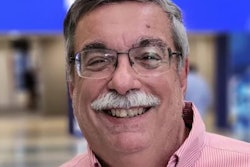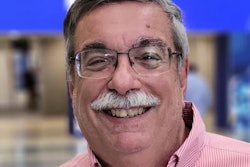
You didn't need to be at RSNA 2022 to understand that the show was like World War II. There was no hand-to-hand fighting or even artillery shells flying overhead, but the number of alliances seen there was amazing.
 Michael J. Cannavo.
Michael J. Cannavo.Some were larger, like the U.S. and U.K., while others were like Greenland, with 26 men patrolling the coast looking for German weather stations. It seems like everyone on the floor had an alliance with someone else, although this was primarily seen with the artificial intelligence (AI) companies doing this. The enterprise imaging systems (EIS)/PACS companies seemed to enjoy playing Don Quixote fighting with windmills.
While a few promoted alliances with the cloud and AI vendors and a few others who offer data migration, dictation/transcription, etc., most played lone wolf. It was interesting to see a few vendors branching out into the electronic medical record (EMR) world, while others expanded into other areas like digital pathology. All are natural extensions of medical imaging.
Fact from fiction
Discerning fact from fiction in the AI world was pretty easy. Many of the people I chatted with had no clue about anything other than what they had to offer and half the time not even that. Global market perspectives completely evaded most. Many were like a two-year old with a new toy, focused on only what they have in their hands.
Now, there are exceptions, mostly from those who have been in the marketplace for a while and really know their stuff, but the newbies continue to be a source of fun and excitement. Over 120 -- many more than in years past -- claim to be in the AI market, making up a full 20% of all RSNA exhibitors. Needless to say, there were lots of New Kids on the Block taking it step by step.
Why so many? Well, there have been so many articles written by academicians and others touting how wonderful AI is that the Kool Aid is flowing as freely as the money from the U.S. Centers for Medicare and Medicaid Services (CMS) for using AI. Why not get on the Gravy Train while you can?
Virtual learning?
Not being at the show I had hoped I could learn just as much virtually. I was wrong. With just 13 vendors showing virtually -- and half of those also showed in person as well -- I felt like I was watching the 1970's movie, "Suppose They Gave a War and Nobody Came." Few of those who were in the virtual area I had even heard of either, so I had to rely on press releases, feedback from several I know who were there, web sites, and other sources.
I guess the experiences people had with trying to do a virtual trade show in years past turned them off to the concept when showing up in person was a viable alternative.
In my other RSNA article I asked, "Should I stay or should I go?" Most who went were glad that they went but all commented on the cost being so much higher than in previous years as well. One person summed it up this way: "The show has been pretty good. There isn't the constant flow of end users into the Halls, at least where we were, as in prepandemic years. We also are not a huge PACS or modality company with a humongous booth and flashy equipment that attracts a lot of hospital end users. So we don't get the constant flow of people we would like. When you go into the common spaces, it looks like a very highly attended show. But in exhibit halls, it dies down in the early afternoon and stays that way for the most part."
They went on "We were able to talk to those who happened to be in the right professional position so that was a plus. But we didn't get to speak to a ton of people in those positions."
Showcase for radiologists
It seems like the show that is pretty much dedicated to radiologists is the best showcase only for products that appeal to them. Ancillary personnel attending the show (radiology directors, the head of imaging services, dealers and distributors, and others who aren't radiologists) are pretty much on their own to find something that can benefit their facility so they can show a return on investment for the trip. There was plenty to see, for sure, but you had to have a GPS that targeted those areas.
Most of the signage didn't help either as many vendors don't even understand their own products and services and how to promote them. Again, another conundrum and story for another day.
Comments were made about foreign attendees making up a larger and larger percentage each year compared with those in the U.S. There are two reasons for that. One is that RSNA is one of the largest shows worldwide aside and draws a heavy contingency from the Far East and Europe.
The second is that support for continuing medical education (CME) credits has been significantly reduced. Many of these can just as easily be done online and require no financial investment or time away from work. Overseas registrants continue to climb each year and now make up close to 40% of the RSNA volume.
That has to be frustrating to many smaller vendors who don't have overseas dealers and distributors and are looking to target a U.S. base of end users only. With professional registration sitting at just over 16,000, maybe 12,000 of those are radiologists (the rest are "others") and just 60% of those in the U.S., you are talking about a potential audience of 8,000 people.
The question then becomes how many of those 8,000 are interested in your products or services and, if so, how do you get to them or have them see you if you are in a 10 x 20-ft booth hidden behind one of the mega vendors? It's another conundrum for sure. If you are selling a multimillion-dollar scanner you need a big presence. But with the PACS/EIS marketplace, highly competitive and primarily a replacement one, and the AI market one, where just getting attention is considered a victory, how do you justify the expense?
Better marketing is step one. This has been the case since I started writing the PACSMan Awards and one that evades a lot of companies. So without further ado, here are the best of the worst marketing attempts, the 2022 PACSMan Awards:
The Just One More Thing Award
Obviously, this overseas company didn't watch a lot of U.S. television, or they may have considered naming their company differently.
The Matthew 28:6 award
To those who sent me notes saying how much they loved my latest write-up, then asked me to come visit their booth even though I said several times I'm not at RSNA this year.
The 10-ft Tall Award
I love this company's name, but the correlation between the name and medical imaging happens to evade me.
The Magilla Gorilla Award
I didn't see Mushmouse, Punkin Puss, Ricochet Rabbit, and Droop-a-Long in the booth, but maybe I just missed them.
The Alias Award
To the dozen or so companies who can't figure out what to call themselves, so they use an alias instead -- which often isn't much better than the name they were using.
The Puff Daddy Award
To all except a select few vendors who seem to take puffery to a new level in their signage and website content.
The Best Place to Start Your Day Award
To the company whose hyperfast EIS advertised using the word "speed" in big letters. If it was one helluva night before and you needed a quick pick-me-up, this was the place to be. The only booth that had more people in it was the one offering free gadolinium.
The Ripples and Wrinkles Award
To the group who decided that "ripples of innovation" was a good term. You haven't lived until you have enjoyed ripples and wrinkles.
The They Killed Kenny Award
For over 20 years, this older woman's face has been a part of the family, looking over all of the RSNA and smiling. This year, she was replaced by half a chest. Oh, the travesty of it all!
The Kermit the Frog Award
To the group who were identified in green letters and definitely are green in so many ways. Kermit said it best, "It ain't easy being green."
The Advanced Education Award
To the group who put on a childcare camp for kids whose parents were at RSNA. Using a tablet to stimulate their interest, the kids, who look in the photo to be somewhere between 3 and 7 years old, were asked things like, "Who can identify the pulmonary embolism?" and "Is a T1-weighted MRI better than a T2?"
And on that note, I'll close a day early. Until next year.
Michael J. Cannavo is known industry-wide as the PACSman. After several decades as an independent PACS consultant, he worked as both a strategic accounts manager and solutions architect with two major PACS vendors. He has now made it back safely from the dark side and is sharing his observations.
His healthcare consulting services for end users include PACS optimization services, system upgrade and proposal reviews, contract reviews, and other areas. The PACSman is also working with imaging and IT vendors developing market-focused messaging as well as sales training programs. He can be reached at [email protected] or by phone at 407-359-0191.
The comments and observations expressed are those of the author and do not necessarily reflect the opinions of AuntMinnie.com.



















